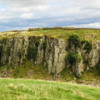1,450 miles from Rome was the limit of the mighty Roman Empire in 122 AD when the Roman Emperor Hadrian came to Britain and took the decision to build this massive stone wall in order to consolidate his rule and the geographical extent of his Empire. Today it spans the northern English counties from Cumbria to Northumberland, running virtually from coast to coast in enormous worked stones.
Hadrian's armies had tried to conquer the 'troublesome tribes', the Picts, who populated Scotland to the north of the wall but the Romans were never been able to secure their gains and found themselves attacked further south and having to retreat and consolidate their positions. So the wall was to be their final defensive line.
80 Roman miles (73 modern miles) of measured, worked, and finished stone wall was then built in 5 mile stretches punctuated by large forts and smaller "mile castles" and signal towers. The wall was constructed by 18,000 soldier-engineers in just 15 years using some 4 million tonnes of stone. Much of the wall was 10 feet thick and towered 16 to 20 feet high. This was no roughly finished wall of piled stones, but an engineering marvel of finished, interlocking stone of which any mason would be proud.
The wall suffered many lesser attacks that were rebuffed, but in 367 AD the wall was again attacked by an alliance of tribes and with the significant Roman victory the Roman peace – ‘Pax Romana’ - was restored for a short time. By AD 400 the Empire which had stretched from Newcastle in Britain to the Nile in Egypt was in crisis and the northern frontier was abandoned leaving behind many of the legionnaires who had intermarried with the local people and become integrated into the local populous.
Over the following 1,500 years, much of the stone from the wall was taken away to build extensive farm walls or great houses throughout northern England. So the once mighty wall now stands, at best, some 5 feet high or in other places has disappeared altogether.
Today, the most dramatic landscape and one of the stretches where the wall remains most intact for the longest distance is on the 10 miles from the Roman Army Museum along the Walltown, Windshields, Highshield, Hotbank Crags to Housesteads Fort. Along this route are well-preserved remains of some of the larger Roman garrisons and particularly at Housesteads there are sufficient remains to really appreciate the magnitude and extent of the settlements.
Today's Pic of the Day is of Hadrian's Wall as it snakes across the peak of the rocky crag opposite Steel Rigg near Housesteads. This is one of the most dramatic places to view the wall and it is breathtaking to see that the wall just continues right off into the distance...


Comments (0)